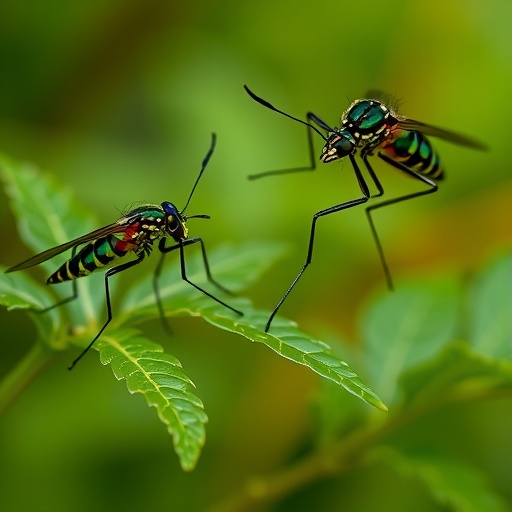In a groundbreaking study set to reshape our understanding of natural remedies against parasitic infections, researchers have delved deep into the biochemical interactions between plant extracts and malaria-causing Plasmodium parasites. The latest evidence emerges from a meticulously conducted investigation into the oxidative stress modulating effects of sub-fractions derived from the aqueous extract of Capsicum frutescens L., commonly known as African bird’s eye chili, on early established Plasmodium infections in murine models. This research not only broadens the horizon of phytotherapeutics but may also signal a paradigm shift in adjunct malaria treatment strategies with implications for global health.
Oxidative stress plays a vital role in the pathogenesis of malaria, resulting predominantly from the parasite’s metabolic activities within host erythrocytes. The imbalance between reactive oxygen species (ROS) generation and the host’s antioxidative defenses leads to cellular damage and contributes to severe clinical manifestations. Targeting oxidative stress pathways has been proposed as a complementary approach to conventional antimalarial therapies, capable of mitigating tissue damage and enhancing recovery. In this light, the present investigation probes the capacity of various sub-fractions of Capsicum frutescens aqueous extracts to reduce oxidative damage during early Plasmodium establishment.
.adsslot_tfGlN6H915{ width:728px !important; height:90px !important; }
@media (max-width:1199px) { .adsslot_tfGlN6H915{ width:468px !important; height:60px !important; } }
@media (max-width:767px) { .adsslot_tfGlN6H915{ width:320px !important; height:50px !important; } }
ADVERTISEMENT
The methodology employed reflects a high degree of precision and scientific rigor. Sub-fractions of the aqueous extract were carefully prepared using differential solvent partitioning techniques, isolating distinct groups of phytoconstituents based on polarity and molecular size. These sub-fractions were then systematically assessed in vivo using murine models infected with early stages of Plasmodium spp., enabling the researchers to examine in situ antioxidant effects in a physiologically relevant environment. Biomarkers indicative of oxidative stress, including malondialdehyde levels, superoxide dismutase activity, and glutathione content, were meticulously quantified.
Remarkably, the results reveal significant antioxidative activity across multiple sub-fractions, with some exhibiting pronounced reductions in lipid peroxidation that directly correlate with lower parasitemia levels. This suggests that the oxidative stress attenuation mediated by Capsicum frutescens extract components may inhibit parasite proliferation or limit pathogenic damage, thereby potentially enhancing host resilience to infection. The interplay of bioactive compounds such as capsaicin and various phenolic compounds likely contributes synergistically to this effect, highlighting the complex multi-targeted nature of botanical therapeutics.
Mechanistically, the study postulates that the sub-fractions operate through scavenging free radicals and upregulating endogenous antioxidant enzymes, thereby restoring redox homeostasis impaired during infection. This dual mechanistic action supports previous biochemical models but advances them by pinpointing specific extract fractions responsible for these effects. The researchers also observed improved hematological parameters in treated mice, underscoring the extract’s capacity to counteract malaria-induced anemia and systemic oxidative damage.
The implications of this research extend beyond malaria alone. Given that oxidative stress underlies a myriad of infections and chronic diseases, understanding how plant-derived antioxidants interact with host-pathogen dynamics opens new avenues for drug development. The utilization of widely available and culturally relevant botanical sources such as Capsicum frutescens also aligns with sustainable healthcare models, particularly in resource-limited settings where malaria remains endemic.
Future studies will undoubtedly need to expand on these findings by isolating individual active compounds within the sub-fractions, determining their pharmacokinetics, and assessing safety profiles in different biological systems. Moreover, exploring synergistic effects with existing antimalarial drugs could reveal important combination therapies that maximize efficacy while minimizing toxicity and resistance emergence.
This work embodies the synergy of traditional knowledge and modern science, validating the medicinal potential of a plant long regarded primarily as a culinary spice. The detailed investigation into Capsicum frutescens shines a spotlight on the molecular underpinnings of its health-promoting effects, paving the way for natural-product-based adjunct therapies that could revolutionize malaria treatment paradigms.
Intriguingly, the study’s comprehensive analytical framework showcases how oxidative stress markers serve as vital endpoints in evaluating therapeutic potential. This approach exemplifies the integration of biochemical assessment with parasitological outcomes, underscoring the importance of multifaceted metrics in infection biology research. It also raises intriguing questions on how other plant species with rich phytochemical diversity may harbor untapped resources for combating oxidative stress-related pathology.
In conclusion, the research by Nwikwe et al. represents a significant advancement in the intersection of phytochemistry, parasitology, and oxidative biology. By demonstrating that sub-fractions of Capsicum frutescens aqueous extract effectively reduce oxidative stress in early Plasmodium infection, the study lays a solid foundation for developing novel antioxidant-based adjunct therapies. This approach promises to enhance the therapeutic arsenal against malaria, addressing persistent global health challenges through innovation grounded in natural product science.
As the fight against malaria continues, this study underscores the critical importance of exploring plant-derived compounds not merely as symptomatic mitigators but as agents capable of influencing underlying pathophysiological processes. The potential translational impact of such research resonates with the global health community’s urgent call for integrative, multifactorial interventions that reduce morbidity and mortality associated with parasitic diseases.
With ongoing efforts to refine extraction processes, characterize active ingredients, and unravel molecular mechanisms, Capsicum frutescens may soon transition from spice racks to pharmaceutical formulations. Such progress highlights the enduring value of ethnobotanical knowledge and the necessity for sustained investment in natural product research, which remains an indispensable pillar in the quest for novel, efficacious, and accessible therapeutics.
Subject of Research: Evaluation of oxidative stress reducing potentials of sub-fractions of Capsicum frutescens aqueous extract on early established Plasmodium infection in mice.
Article Title: Evaluating the Oxidative Stress Reducing Potentials of Sub-Fractions of Capsicum Frutescens L. Aqueous Extract on Early Established Plasmodium in Mice.
Article References:
Nwikwe, D.C., Ofeniforo, B.E., Asogwa, N.T. et al. Evaluating the Oxidative Stress Reducing Potentials of Sub-Fractions of Capsicum Frutescens L. Aqueous Extract on Early Established Plasmodium in Mice. Acta Parasit. 70, 181 (2025). https://doi.org/10.1007/s11686-025-01121-z
Image Credits: AI Generated
Tags: antioxidant properties of chili peppersbioactive compounds from plantsCapsicum frutescens benefitsdrug resistance in malaria treatmentethnomedicinal use of Capsicumglobal health implications of malaria researchmurine models in malaria researchnatural remedies for parasitic infectionsphytochemical profile of African bird’s eye chiliphytotherapeutics in malaria treatmentPlasmodium parasite interactionsreducing oxidative stress in malaria





